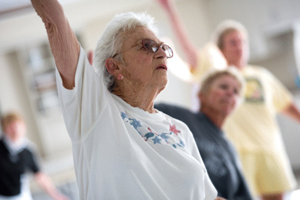NEW research confirming the benefits of exercise for the elderly puts the onus on doctors to encourage older patients to get moving, experts say.
A systematic review of 54 randomised controlled trials, published in the NSW Public Health Bulletin in a special issue on falls prevention, found that exercise reduces the rate of falls by about 16% (pooled rate ratio). (1)
And a study published last week in Neurology found that older people with the highest level of physical activity were 40% less likely to have a silent brain infarct than their inactive counterparts. (2)
Professor Adrian Bauman, professor of public health at the University of Sydney, said the research added to a growing body of evidence that exercise reduced the risk of diseases ranging from diabetes to Parkinson’s disease.
“Exercise is probably the most important thing for older people’s health, but actually getting them to do it is tricky”, he said.
Associate Professor Cathie Sherrington, a senior research fellow at the George Institute, University of Sydney, said there was a need for more community education about the benefits of exercise in older people.
“Some people think they’re too old to exercise, or their children think it’s not appropriate”, said Professor Sherrington, who was a coauthor of the systematic review.
Both experts suggested several practical strategies that doctors could use to encourage older patients to exercise.
Professor Bauman suggested that doctors ask older patients about their activity levels and recommend, or even prescribe, light to moderate exercise as appropriate.
“Every doctor asks every patient about their smoking, but they don’t always ask about their activity levels.”
Professor Bauman said the most important strategy was for doctors to encourage patients to start small and to emphasise that exercise “doesn’t have to be about Lycra”.
Doctors could also have a list of local exercise programs or resources on hand to recommend to older patients.
The NSW government has recently launched a searchable database of exercise activities for older people. (3)
The Heart Foundation also runs popular walking groups, led by a walking organiser, as well as exercise programs for people with heart conditions. (4)
Professor Sherrington said all doctors had a role in encouraging patients to exercise and emphasised that all older people, not just the frail, benefit from exercise.
Although several state governments had falls prevention programs, Dr Sherrington said more could be done at a policy level. “But things are moving in the right direction”, she said.
Professor Sherrington suggested additional funding for exercise programs, or financial incentives to encourage more elderly people to participate in exercise programs.
The systematic review found that exercise programs that included balance training, a higher dose of exercise and did not include walking had the greatest effect on reducing falls.
Perhaps, surprisingly, the study found that the inclusion of walking training was associated with a lesser reduction in the rate of falls. Professor Sherrington said that one trial had found that brisk walking programs increased the rate of falls among high-risk older people.
“That was a tricky finding”, she said. “There are loads of benefits of walking but it does increase exposure to the risks”.
The paper recommended that, for falls prevention, exercise should provide a moderate to high challenge to balance and be undertaken for at least 2 hours a week on an ongoing basis. Strength and walking training may be included in addition to balance training.
A recent Cochrane Review on falls found that the effects of exercise as a single falls prevention intervention are comparable to those from multifaceted interventions. (5)
— Sophie McNamara
1. NSW Public Health Bulletin 2011; 22: 78-83.
2. Neurology 8 June 2011 (online)
3. NSW government: Active & healthy
4. Heart Foundation: Active living
Posted 14 June 2011

 more_vert
more_vert